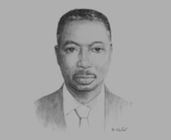George Osahon, Director, Department of Petroleum Resources (DPR): Interview

Interview: George Osahon
What sort of initiatives will the DPR be undertaking to encourage development of marginal fields?
GEORGE OSAHON: We have a number of awareness campaigns on the operation of marginal fields targeted at existing holders. Only eight of the 24 fields awarded in 2003 are on-stream, while the others face challenges ranging from technical through financial to managerial issues, including poor cooperation among parties. We are looking into these challenges with a view to assisting. The information and knowledge acquired regarding the workings of the current set of marginal fields would inform the manner in which future marginal field programmes will be handled.
In what ways will the regulatory framework be affected by the increase in local participation?
OSAHON: Apart from the increase in the participation of indigenous oil and gas companies, the industry landscape itself is bound to change with time, and as regulators, we must be at the forefront of managing this change. For example, as fields are depleted, operators may introduce secondary recovery technologies and would have to grapple with the challenge of decommissioning, which has not been an issue in the past.
The challenge for local players is their limited operational experience and lack of support mechanisms which the major operators enjoy. Also, a number of the local players are not capable of handling large projects and may need to engage the support of consultants, raising the cost of implementation.
We cannot leave anything to chance. We have started putting into place guidelines and, where necessary, standard procedures for different aspects of operations. That would enable relatively young companies to appreciate the extent of their responsibilities.
What is needed to ensure consistent and equally priced petroleum products?
OSAHON: The answer is information. If we know what is happening at the depots, in the transmission or transportation areas, and the filling stations, it becomes easy to identify challenges and deal with them. We have 122 depots in the country, 65 of which are in the Lagos area. Several hundred trucks are used every day to transport petroleum products, furthering the government’s bridging policy, and we have 27,700 filling stations, excluding those that have not registered their facilities. With such a spread of facilities, it will be difficult for the DPR, with its 22 offices nationwide, to cover all of them using a manual approach. We are therefore studying the methods that will be deployed to simplify information gathering and facilitate effective monitoring of the activities of industry players.
How would you rate the level of success in eliminating the practice of flaring so far?
OSAHON: This includes both private and public operators as they are equally bound by the law regarding all oil and gas operations, including gas flaring. The effort to eliminate flaring is ongoing, and even when we achieve zero flare we have to continuously monitor operations to ensure compliance. Keeping in mind that gas flaring has been reduced by as much as 75% to the current level of 1.1bn cu feet, or 13% of the country’s daily production, major strides have been made.
Several initiatives are being put in place to achieve flare-out in which the sanction approach is giving way to commercial overtures on the part of the government. In 2014 the government increased the price of gas supplied to the domestic market from $1 to $2.50 per thousand cu feet. The government is also settling the huge debt owed to gas supply companies by the power industry. All these are meant to encourage investment in gas operation and reduce flaring. Operators of gas flaring fields are being encouraged to involve the participation of third-party investors in harnessing gas that would otherwise be flared. The idea is not new, but its implementation was hampered by technical, commercial and taxation issues in respect of which the DPR is about to put guidelines in place.
You have reached the limit of premium articles you can view for free.
Choose from the options below to purchase print or digital editions of our Reports. You can also purchase a website subscription giving you unlimited access to all of our Reports online for 12 months.
If you have already purchased this Report or have a website subscription, please login to continue.

